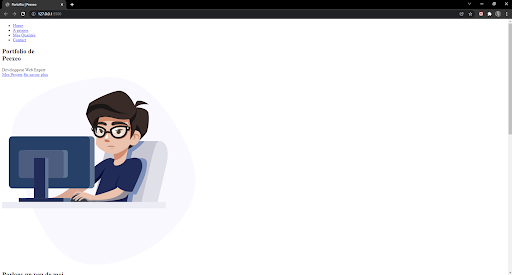Published on 22 February 2022 (Updated 17 November 2023)
Before starting, it is important to be clear about what a web developer is.
He/She designs custom sites or adapts existing technical solutions to suit the project and customer requirements.
The aim is to develop tailored web interfaces for clients. It can be intranet sites, internet sites, web applications or any online tools.
The main languages used to create such websites or web applications are HTML, CSS, JavaScript, MySQL and PHP.
Developers can use the so-called CMS, a software package that aims at structuring website content in an easier and more automated way.
Beginning with HTML
HyperText Markup Language, or HTML, is the basic language of websites. It is not a programming language but a markup language that allows you to write hypertext in order to define the semantic structure of a web page.
A hypertext refers to one or more documents that contain units of information (video, text, image, sound, etc.) linked together by hyperlinks (the famous href).
It is used to define the structure of a document. HTML allows you to add titles (H1, H2, H3…) as well as bulleted lists, forms and images.
Here is an example of a site with only HTML:

Understanding CSS
Cascade Style Sheet, or CSS, is the language that will enable us to define the form given to our document. Despite its simple syntax, its vocabulary is relatively large.
There exist several CSS frameworks (a framework is a library comprising a set of tools and components to simplify and standardize the work of developers).
CSS allows, in particular, to add colors, margins, borders, and hover effects to different elements.
Here is the same example of a site, but this time with CSS:

That’s right, the site becomes immediately more pleasing to the eye.
Heading toward the JavaScript
JavaScript is a programming language that allows complex mechanisms to be implemented on a web page.
JavaScript allows to set up processes and to interact with the users who visit a web page (for example). It allows us to set up a variety of controls, such as checking whether a field has been filled in, displaying an alert, managing visual effects…
With Javascript frameworks, such as Jquery, the possibilities offered by this programming language are multiplied tenfold which makes it possible to enrich the user interface.
Naturally, Javascript is used in HTML.
The parts of Javascript code are delimited by specific tags ()
Be careful not to confuse Javascript with JAVA, which is an object-oriented programming language that has had numerous security flaws over the years. Since 2010, WEB browser editors have reacted by automatically blocking Java applets. It is therefore very important to secure your WordPress site
Here are some examples of what JavaScript can help you with:
- Verification of input in forms (address, email)
- Simple calculations following form entries (Prices, calculator)
- Search engine (search base defined by the webmaster)
- Date and time management (Current date, Update date, Calendars)
- Cookie management (Saving information: number of visits, virtual shopping cart)
- Navigation management (Dynamic menus, popup)
- Graphic animations (Dynamic HTML, MouseOver, rotating banners, games)
- Creation of web applications with Ajax calls to the server
- Creation of games
Using jQuery
jQuery is a free, open-source, cross-platform JavaScript library compatible with all browsers. It is the best-known and most widely used JavaScript framework.
With jQuery, you can for example :
- Add, delete or modify HTML elements within your page.
- Change the styles of page elements by modifying the CSS associated with them.
- Animate elements on your page.
- Send and receive data from a server using AJAX
Furthermore, using jQuery allows you to be compatible with different browsers.
Pure JavaScript is known to have specificities between each browser such as Internet Explorer, Chrome, Safari, etc., which will potentially execute your JavaScript code differently from each other and therefore risk rendering your codes obsolete.
This compatibility is made possible by the use of CSS selectors.
Selecting elements becomes faster and more straightforward than with traditional JavaScript, and since web developers understand already CSS selectors, they should have no trouble using jQuery.
Progressing in PHP
PHP is an open source scripting language particularly suitable for web development.
What distinguishes PHP from JavaScript is its execution. JavaScript is executed on client side, whereas PHP is executed on server side.
It allows developers to create dynamic websites, which can be administered through MySQL.
MySQL is a database management system. Its role is to store data in the form of tables, and to allow the manipulation of this data through SQL query language.
Here are some examples of what PHP can do:
- Automate the management of articles or other elements of your site.
- Manage the content of your administrations.
- Manage photo galleries, link directories, polls, forums, internal search engines, etc.
- Implement sorting and hashing functions, string processing, image generation and modification, compression algorithms, etc.
It is from this moment that you will have acquired all the knowledge and tricks of a web developer and will be versatile enough to handle all kinds of tasks.
Becoming a web developer
If you’ve resisted the urge to run away from all these terms, that’s a good sign!
But there is still one crucial thing that decides whether you are able to become a web developer or not: Your passion for this profession!
Becoming a web developer requires you to always ask yourself questions, to always doubt what you know and above all to never stop improving yourself and perfecting your “art”.
After acquiring all this knowledge, you will be officially qualified as a web developer!





